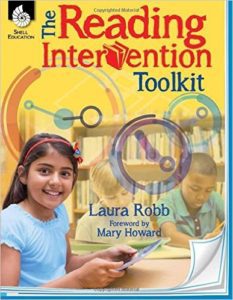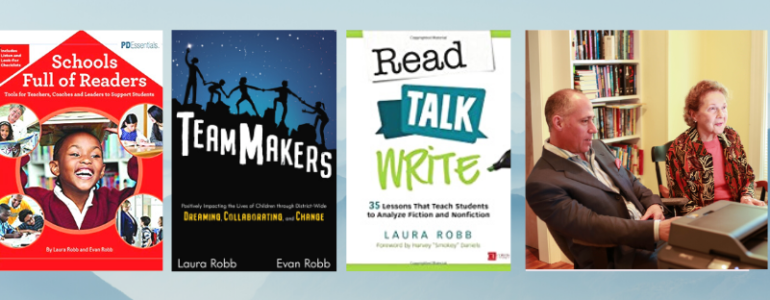by Laura Robb
Each year, education publishers, promote programs that offer guarantees for boosting reading scores and transforming striving readers into students who read well and widely. These programs require total fidelity from teachers if students are to show progress on assessments. The problem is in order to show progress, most program’s assessments focus on collecting data only on the program’s materials that students have practiced. And data includes phonics, phonemic awareness, and fluency exercises; syllabication practice and worksheets with a short text and questions that test recall of information. I take issue with these programs because:
- They don’t know anything about the children you teach: their strengths, needs, interests, and feelings about reading.
- They include short texts that don’t build the stamina students need to concentrate on reading a book. Moreover, a diet of recall questions makes reading boring and fails to engage students in analytical and critical thinking.
- Reading wonderful books is not part of their intervention protocols.
Fragile learners—students three or more years behind their grade level—continue to lose reading ground because they aren’t reading. Instead, they’re practicing skills in isolation, out of the context of reading. In fact, they don’t have opportunities to practice and apply strategies and skills because their reading volume of books is close to zero. In his 1977 article, “If They Don’t Read Much, How Are They Ever Gonna Get Good?” Richard Allington wrote:
“Too often the procedures commonly employed in remedial and corrective reading instruction seem to mitigate against developing reading ability by focusing more on the mastery of isolated skills with relatively little emphasis on or instructional time devoted to reading in context. To become a proficient reader, one needs the opportunity to read. “
Allington’s words ring true today! For striving readers to improve and move forward, they need fifteen to twenty minutes every day at school to read self-selected books they can and want to read. Teachers help them select “good fit” books that they can enjoy and that inspire them to read more!
What’s the Purpose of Interventions?
A question that teachers and administrators should revisit a few times a year, so they remain grounded in responding to the kinds of interventions appropriate for each student. For me, the answer to this question is to help striving readers thrive and become proficient readers who love to read and choose reading at school and at home. The best way to accomplish this is by helping students find books they want to and can read and enjoy. This means having a rich classroom library, with multicultural books on diverse reading levels that are relevant to students’ lives.
Once Students Are Reading, What Else Can Teachers Do?
In student-centered classrooms, teachers have an abundance of interventions at their fingertips. Confer with students to discover their feelings toward reading and whether their reading is fluent and expressive. Listen to students’ discussions with a partner and small group to gain insights into how they view characters, conflicts, problems, and why characters change. You’ll notice whether students are inferring and drawing conclusions, pinpointing big ideas, etc. Read students’ notebooks for their written responses reveal their reactions, questions, and depth of comprehension and understanding. Then decide whether you need to meet with individuals or small groups to think-aloud, model, or re-teach a lesson. Or, you might pair-up students who can support one another with notebook writing, figuring out tough words using context clues, etc.
Note that the interventions grow out of the needs each child exhibits based on their instructional and independent reading. Everyone won’t need the same interventions. You, the skilled teacher, can develop interventions that are flexible and respond to and meet the needs of each child.
Why is the Classroom Teacher Important?
The classroom room teacher is the most important interventionist. The research completed by Gretchen Owocki (2010) points out that a skilled core curriculum teacher can improve the reading of 80 percent of his/her students. Daily interactive read alouds, where the classroom teacher thinks aloud to model how he/she feels about a book, reacts to the story, figures out tough words using context, and applies strategies are interventions. Students’ self-selecting books for daily independent reading is an intervention that offers them time to practice and apply strategies. Instructional reading, supporting students’ growth as they read books that stretch their reading capacity with their teachers’ support, is an intervention. Notebook writing about reading that asks students to analyze and think deeply about texts is an intervention. Discussing books to develop critical thinking is an intervention. Conferring that invites teachers to model and think-aloud and then asks students to practice, is an intervention.
Somehow we’ve lost our way and bought into the notion that worksheets, isolated skill-and-drill lead to reading proficiency and joy in reading. Unfortunately, the results of the 2019 NAEP (The National Assessment of Educational Progress) tests in reading for grades 4 and 8 show the opposite. Scores have been flat for ten years, and 67 percent of fourth-graders who took the NAEP in 2019 read below proficient. When students achieve a proficient score on the NAEP, it indicates that they have learned enough in fourth or eighth grade to do well in the next grade. This. Isn’t. Happening. The result? Too many students are being left behind!
We Can Do Better
We can and must do better. It’s time to listen to Richard Allington who cautions teachers that our most fragile readers need to have texts of appropriate difficulty in their hands all day long (my italics). This means that schools invest in books at diverse reading levels so that every child will be reading throughout the day in social studies, science, math, electives, and during library classes. Yes, reading is an intervention! And when students practice the skills related to reading expertise in the context of wonderful, inviting and engaging books, teachers can change the trajectory of their students’ reading lives.
Laura has written many excellent books! Check out The Reading Intervention Toolkit

Follow Laura on Twitter @LRobbTeacher
Follow The Robb Review Facebook Page!
![]()













